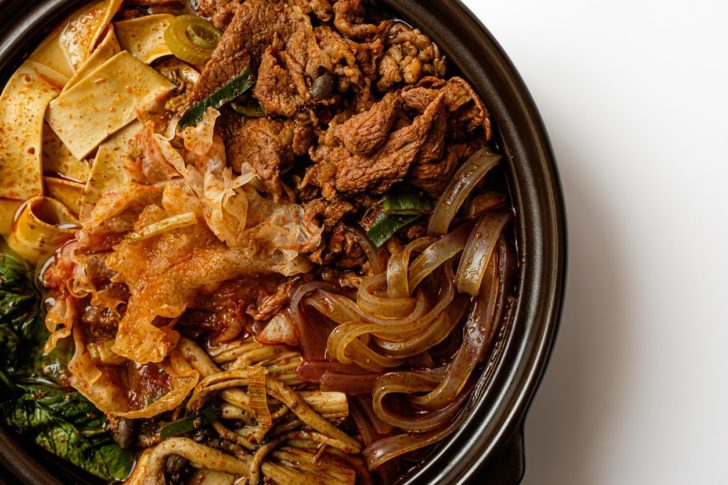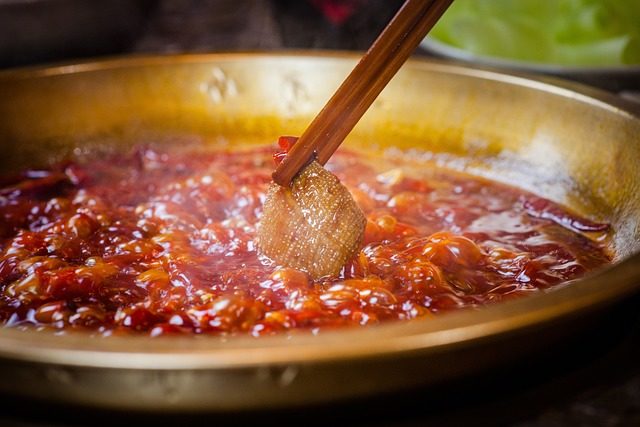Ready to embark on a flavorful journey to China and indulge in a delicious, spicy hot pot dish? Malatang, a popular Sichuan cuisine, is just what you’re looking for! In this blog post, you’ll discover the origins, unique taste, and the art of creating your own Malatang experience at home. So, let’s dive in and explore the world of Malatang!
Table of Contents
Key Takeaways
Explore the bold and spicy flavors of traditional Sichuan dish, Malatang.
Create your own delicious version at home with our expert advice on ingredients, broth and cooking tips!
Enjoy it with side dishes & drinks for a truly unique culinary experience, store in fridge or freezer to keep fresh.
Understanding Malatang: A Flavorful Journey

Hailing from Sichuan, China, along the Yangtze River, Malatang has its roots in the lives of locals who made a living by towing boats upstream. This spicy hot pot dish has since become a favorite among food enthusiasts, not only in China but around the world. So, what makes Malatang stand out from other Chinese hot pot variations? One key difference is the inclusion of thinly sliced beef as one of its ingredients.
The name “Malatang” itself is a combination of two Chinese words – “ma” meaning “numbing” and “la” meaning “spicy”. This unique taste profile is often garnished with toasted sesame seeds for added flavor and texture. Malatang can be found at small shops and street vendors, especially in Sichuan or Chengdu.
Without a doubt, the bold, spicy flavors of Malatang have a captivating effect that keeps you craving more.
The Unique Taste of Malatang
For those drawn to spicy hot pot dishes, Malatang will certainly captivate your palate. This speedy spicy hot pot offers a unique blend of spicy, numbing, and rich flavors. Some variations even use fermented sweet rice to enhance the taste. Malatang’s reddish broth carries a spicy and nutty flavor profile, often using bone broth as a base to add depth and richness to the dish.
The broth that brings the authentic Sichuan spicy and numbing taste is made from a combination of different ingredients. These include:
dried chilies
Sichuan peppercorns
spices
fermented bean chili sauce
beef fat
If you’re looking for a quick way to make the broth, grab a pre-packaged hot pot soup base from the grocery store or online. Add thinly sliced meat to the boiling broth to cook quickly and absorb the flavors.
Malatang’s popularity has crossed borders and found its way into Korean cuisine as well. Its unique and flavorful broth has captured the hearts and taste buds of spicy food lovers around the world.
Check out Why is Malatang so popular in Korea?
Creating Your Own Malatang Experience
Eager to recreate the Malatang experience in your own kitchen? In the subsequent portions of this guide, we’ll walk you through:
the selection of ideal ingredients
the creation of a savory broth
providing you with expert advice on cooking and serving to guarantee an authentic and delectable Malatang meal.
Choosing Your Ingredients

When it comes to Malatang, the possibilities for ingredients are endless. Some popular options include:
Sweet potato noodles
Tofu skin
Wood ear fungus
Meat (such as beef or chicken)
Vegetables (such as cabbage, spinach, or mushrooms)
Spam
The variety of ingredients allows you to create a dish that’s uniquely yours. Proteins like tofu, fish balls, and beef can be added to the mix for a more substantial meal.
To prepare the ingredients, soak wide sweet potato noodles for an hour, follow package instructions for tofu skin, and soak wood ear fungus for 45-90 minutes before boiling for 2-4 minutes. Popular add-ins for Malatang include mushrooms, sliced tofu skin, potatoes, Spam, wood ear fungus, greens, thinly sliced meat, and noodles, among others.
The secret to a tantalizing Malatang is in the mix of ingredients you opt for. So, don’t be afraid to experiment and find the perfect mix that suits your taste buds!
Crafting the Perfect Broth
To create an authentic and flavorful Malatang broth, start with a hot pot base, soy sauce, and water. The secret to a rich and nutty thickness lies in adding sesame paste to the mix. The base of the broth often consists of:
beef fat
chilis
Sichuan peppers
garlic
salt
ginger
For a genuine taste, use Sichuan peppers, chilis, and other spices in your broth. The ideal ratio of broth to add-ins is to have most of the pot filled with ingredients, with the broth barely covering them.
The creation of a flawless Malatang broth is considered an art form. By following these guidelines and experimenting with the various spices and ingredients, you’ll be well on your way to creating a mouthwatering Malatang experience at home.
Cooking and Serving Tips
To cook your Malatang to perfection, follow the order of how long each ingredient needs to cook. Start with the ones that take the longest, and then move on to the ones that take less time, with the noodles going in last. Medium heat is ideal for cooking Malatang, and each ingredient should be cooked for around 5 minutes after the water or chicken stock has boiled.
When it comes to serving Malatang, presentation is key. Here’s how to do it:
Arrange the cooked ingredients in a large bowl.
Pour the hot broth over them.
Garnish with green onions, toasted sesame seeds, or fried tofu puffs for added flavor and texture.
Mastering the art of cooking and serving Malatang takes practice, but with these expert tips, you’ll be impressing your friends and family with a delicious and authentic Malatang meal in no time!
Customizing Malatang to Suit Your Preferences
A major advantage of Malatang is its adaptability to individual tastes. To adjust the spice level, simply tweak the amount of chili peppers or spicy seasonings in the broth. Start off small and build up to your desired spiciness. For a completely different flavor, try adding:
fresh seaweed
Vienna sausage
squid
tofu puff
kimchi dumplings
to your Malatang.
Malatang can also cater to various dietary preferences, such as vegetarian or vegan options. The type of meat you use, like beef, chicken, or seafood, can impact the overall flavor of the dish, as it absorbs the spicy and numbing broth. If you’re not a fan of Sichuan pepper, feel free to swap it out for alternatives like Tellicherry peppercorns, black peppercorns, Tasmania peppercorns, juniper, sumac, or coriander.
With a little creativity and experimentation, you can easily customize Malatang to suit your personal taste preferences, creating a dish that’s truly unique to you.
Malatang Around the World
The worldwide appeal of Malatang is clear, with fans in countries such as South Korea and North China, including Beijing. While unique regional adaptations of Malatang are yet to be discovered, its adaptation for Western palates is noticeable. Adjustments in spiciness and the addition of more vegetables and protein options cater to different taste preferences.
Incorporating local ingredients and flavors into Malatang creates a fusion of cuisines, and milder broth options are also available to suit a wider range of palates. The key factors contributing to the worldwide popularity of Malatang are:
Customizability
Unique cooking process
Distinct flavor
Cultural significance
Potential health benefits
As Malatang continues to gain popularity around the world, it’s exciting to see how this flavorful dish will evolve and adapt to different cultures and taste preferences.
Pairing Malatang with Side Dishes and Drinks
To further enhance your Malatang experience, think about accompanying it with harmonious side dishes and beverages. In China, traditional side dishes include:
Dumplings
Lotus root
Quail eggs
Spam
Chinese yam
Beef balls
Fish balls
Bean curd
Lettuce
Spinach
Broccoli
Other mixed greens
For beverages, Malatang is commonly enjoyed with tea or other non-alcoholic drinks.
If you’re looking to pair Malatang with wine or beer, consider a crisp Sauvignon Blanc, a zesty Gruner Veltliner, a bubbly blanc de blancs Champagne, sake, or a light pale ale. To balance the spiciness of Malatang, consider adding dairy products like heavy cream, yogurt, sour cream, or butter, or citrus fruits like lemon, lime, or orange.
Pairing Malatang with the right side dishes and drinks enhances the overall dining experience, turning your meal into a true culinary adventure.
Storing and Reheating Malatang
To maintain the taste and safety of your leftover Malatang, follow these storage guidelines:
Refrigerate it for no more than three days.
Use leakproof containers with sealed lids for optimal storage.
If you have leftover Malatang soup base, you can store it in a container in the freezer for up to eight months.
When it’s time to enjoy your leftovers, reheat Malatang on the stove before eating. To ensure food safety, follow these guidelines:
Cover leftovers or store them in airtight packaging or containers.
Wash your hands with soap and water before handling food.
Keep raw food separate from cooked food.
Maintain refrigerator temperature at 36-38°F.
Use a food thermometer to check the internal temperature of the food when reheating.
With proper storage and reheating techniques, you can enjoy your Malatang leftovers without compromising on taste or safety.
Summary
In this blog post, we’ve explored the fascinating world of Malatang, from its origins in Sichuan, China, to its unique taste and global popularity. We’ve also shared tips and tricks for creating your own Malatang experience at home, customizing it to your preferences, and pairing it with side dishes and drinks. Whether you’re new to Malatang or a seasoned fan, we hope this blog post has inspired you to embark on your own flavorful journey and create unforgettable Malatang memories.
Frequently Asked Questions
What is Korean malatang?
Korean malatang is a type of hot pot characterized by its communal nature and spicy flavor. It is typically served in a large pot for multiple people to share, as opposed to traditional hot pot served at a table.
What is the difference between hotpot and malatang?
Hotpot is a group activity that requires preparation time, while malatang is ready-made by the vendor and served in individual servings.
What is malatang sauce made of?
Malatang sauce is made from salted chili peppers, soy sauce, soybean oil, dried chili peppers, monosodium glutamate and disodium 5′-inosinate and disodium 5′-guanylate as flavor enhancers, Sichuan peppers, fermented soybean paste, sugar and spices.
What is the origin of Malatang?
Malatang originated in Sichuan, China, along the Yangtze River, where locals made their living by towing boats upstream.
What are some common ingredients in Malatang?
Common ingredients in Malatang include sweet potato noodles, tofu skin, wood ear fungus, meat, vegetables, tofu, and Spam.









